
What is Blockchain, How does it Work and How can it be Used?
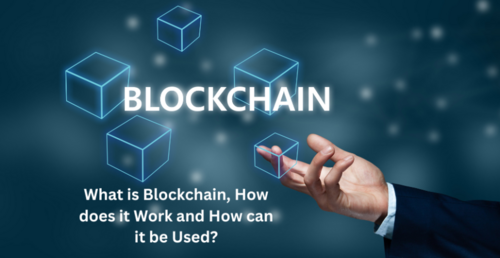
Blockchain is the innovative database technology that’s at the heart of nearly all cryptocurrencies. By distributing identical copies of a database across an entire network, blockchain makes it very difficult to hack or cheat the system.
While cryptocurrency is the most popular use for blockchain presently, the technology offers the potential to serve a very wide range of applications.
At its core, blockchain is a distributed digital ledger that stores data of any kind. A blockchain can record information about cryptocurrency transactions, NFT ownership or DeFi smart contracts.
While any conventional database can store this sort of information, blockchain is unique in that it’s totally decentralized. Rather than being maintained in one location, by a centralized administrator—think of an Excel spreadsheet or a bank database—many identical copies of a blockchain database are held on multiple computers spread out across a network. These individual computers are referred to as nodes.
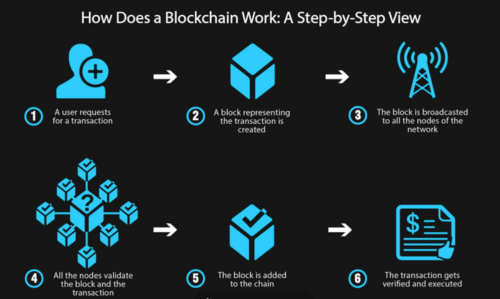
The name blockchain is hardly accidental: The digital ledger is often described as a “chain” that’s made up of individual “blocks” of data. As fresh data is periodically added to the network, a new “block” is created and attached to the “chain.” This involves all nodes updating their version of the blockchain ledger to be identical.
How these new blocks are created is key to why blockchain is considered highly secure. A majority of nodes must verify and confirm the legitimacy of the new data before a new block can be added to the ledger. For a cryptocurrency, they might involve ensuring that new transactions in a block were not fraudulent, or that coins had not been spent more than once. This is different from a standalone database or spreadsheet, where one person can make changes without oversight.
“Once there is consensus, the block is added to the chain and the underlying transactions are recorded in the distributed ledger,” says C. Neil Gray, partner in the fintech practice areas at Duane Morris LLP. “Blocks are securely linked together, forming a secure digital chain from the beginning of the ledger to the present.”
Transactions are typically secured using cryptography, meaning the nodes need to solve complex mathematical equations to process a transaction.
“As a reward for their efforts in validating changes to the shared data, nodes are typically rewarded with new amounts of the blockchain’s native currency—e.g., new bitcoin on the bitcoin blockchain,” says Sarah Shtylman, fintech and blockchain counsel with Perkins Coie.
There are both public and private blockchains. In a public blockchain, anyone can participate meaning they can read, write or audit the data on the blockchain. Notably, it is very difficult to alter transactions logged in a public blockchain as no single authority controls the nodes.
A private blockchain, meanwhile, is controlled by an organization or group. Only it can decide who is invited to the system plus it has the authority to go back and alter the blockchain. This private blockchain process is more similar to an in-house data storage system except spread over multiple nodes to increase security.
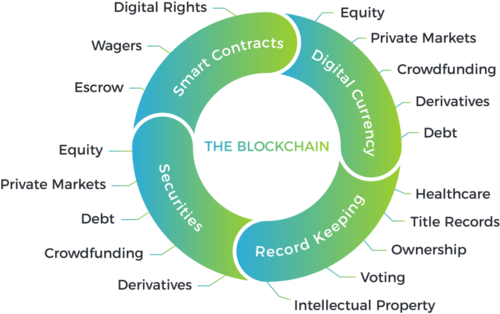
Blockchain technology is used for many different purposes, from providing financial services to administering voting systems.
The most common use of blockchain today is as the backbone of cryptocurrencies, like Bitcoin or Ethereum. When people buy, exchange or spend cryptocurrency, the transactions are recorded on a blockchain. The more people use cryptocurrency, the more widespread blockchain could become.
“Because cryptocurrencies are volatile, they are not yet used much to purchase goods and services. But that is changing as PayPal, Square and other money service businesses make digital asset services broadly available to vendors and retail customers,” notes Patrick Daugherty, senior partner of Foley & Lardner and lead of the firm’s blockchain task force.
Beyond cryptocurrency, blockchain is being used to process transactions in fiat currency, like dollars and euros. This could be faster than sending money through a bank or other financial institution as the transactions can be verified more quickly and processed outside of normal business hours.
Blockchain can also be used to record and transfer the ownership of different assets. This is currently very popular with digital assets like NFTs, a representation of ownership of digital art and videos.
However, blockchain could also be used to process the ownership of real-life assets, like the deed to real estate and vehicles. The two sides of a party would first use the blockchain to verify that one owns the property and the other has the money to buy; then they could complete and record the sale on the blockchain.
Using this process, they could transfer the property deed without manually submitting paperwork to update the local county’s government records; it would be instantaneously updated in the blockchain.
Another blockchain innovation are self-executing contracts commonly called “smart contracts.” These digital contracts are enacted automatically once conditions are met. For instance, a payment for a good might be released instantly once the buyer and seller have met all specified parameters for a deal.
“We see great potential in the area of smart contracts—using blockchain technology and coded instructions to automate legal contracts,” says Gray. “A properly coded smart legal contract on a distributed ledger can minimize, or preferably eliminate, the need for outside third parties to verify performance.”
Supply chains involve massive amounts of information, especially as goods go from one part of the world to the other. With traditional data storage methods, it can be hard to trace the source of problems, like which vendor poor-quality goods came from. Storing this information on blockchain would make it easier to go back and monitor the supply chain, such as with IBM’s Food Trust, which uses blockchain technology to track food from its harvest to its consumption.
Experts are looking into ways to apply blockchain to prevent fraud in voting. In theory, blockchain voting would allow people to submit votes that couldn’t be tampered with as well as would remove the need to have people manually collect and verify paper ballots.
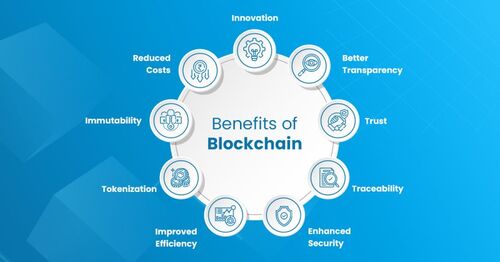
Because a blockchain transaction must be verified by multiple nodes, this can reduce error. If one node has a mistake in the database, the others would see it’s different and catch the error.
In contrast, in a traditional database, if someone makes a mistake, it may be more likely to go through. In addition, every asset is individually identified and tracked on the blockchain ledger, so there is no chance of double spending it (like a person overdrawing their bank account, thereby spending money twice).
Using blockchain, two parties in a transaction can confirm and complete something without working through a third party. This saves time as well as the cost of paying for an intermediary like a bank.
“It has the ability to bring greater efficiency to all digital commerce, to increase financial empowerment to the unbanked or underbanked populations of the world and to power a new generation of internet applications as a result,” says Shtylman.
Theoretically, a decentralized network, like blockchain, makes it nearly impossible for someone to make fraudulent transactions. To enter in forged transactions, they would need to hack every node and change every ledger. While this isn’t necessarily impossible, many cryptocurrency blockchain systems use proof-of-stake or proof-of-work transaction verification methods that make it difficult, as well as not in participants’ best interests, to add fraudulent transactions.
Since blockchains operate 24/7, people can make more efficient financial and asset transfers, especially internationally. They don’t need to wait days for a bank or a government agency to manually confirm everything.
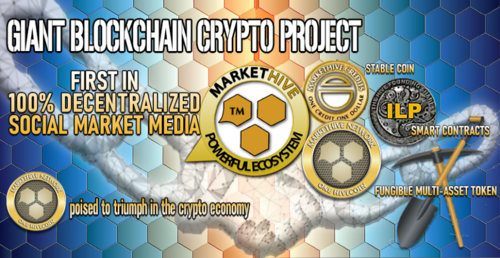
Markethive is currently situated on the 3rd generation Blockchain developed by Solana. The Blockchain protocol has the advanced capabilities to produce the distributed database system Markethive requires.
This ensures that all data that the extensive user base inherently creates in a social media environment is decentralized and safely integrated, and stored on the blockchain, including all forms of content, videos, images, etc.
It is considered a mammoth task for a blockchain and not conducive for an established social media platform like Facebook, with its trillions upon trillions of data already in its system. Markethive conceived and initiated this blockchain protocol, making it easier to integrate. We just had to wait for the right technology to surface.
Thanks to technology evolution, the Markethive social market network’s ability to build a massive database management blockchain can only be done on a 3rd generation blockchain platform. The Markethive blockchain will be forked off the 3rd generation blockchain, with HVC being a native token, a fungible multi-asset token.
Native tokens represent value and act as an accounting unit, which can be used for payments and transactions and sent to an exchange address. Native means that these tokens are supported by the main chain’s accounting ledger without the need for additional smart contracts, as the ledger features built-in support to track ownership and transfer of more than one type of asset.
Ethereum blockchain issues tokens through a custom-coded smart contract, which issues a non-native token. This token won't have all the advantages of Ethereum, and you have to pay for smart contract execution every time you move your token. This is why people complain about Ethereum fees being so high. It's not very efficient, leaving the door open for human error when coding smart contracts.
The low cost in transactional fees and the increased throughput into the thousands make Solana a favorite in future-generation blockchains. A sustainable, scalable financial operating system is becoming a reality.
It allows us to be completely decentralized financially with complete autonomy and protection of our intellectual property, ascertaining a viable and comprehensive ecosystem. This bodes exceptionally well for the Markethive ecosystem and benefits all participating in it.
Essentially the Markethive ecosystem has its own financial operating system within the new global financial operating system or future of internet money envisioned by the architects of the emerging technology, strides ahead of the initial technology of Bitcoin and Ethereum.
Markethive’s vision is a fully decentralized social network inbound marketing platform integrated and operated on a massively distributed database system, the internal giant blockchain, controlled by a smaller external blockchain Markethive’s Dapp wallet will utilize.
This is a very advanced technology Markethive is integrating, which no other platform is doing or will attempt to do. It is a vast undertaking and needs to be done right so security is not compromised on all levels, hence the methodical and time-consuming approach. Markethive is incomparable to any other media platform and, although touted it that couldn’t be done, is 90% done.
It’s about looking after the community, the products and projects, the use, and the utility. Getting it right, being clever and evolutionary will pay huge dividends in the mid to long term for everyone in the ecosystem. Markethive is always focused on where we are going and why we are going there in the mission, giving economic sovereignty and identity to all, especially those that don’t have it.
I know it’s hard to get your head around. Most people don’t comprehend what we have in our midst with Markethive but rest assured, this gigantic all-in-one platform currently flying under the radar will be a life-changing positive force in how we work, earn, and socialize online.
Come to our Sunday meetings at 10 am MST as we approach massive major upgrades and be the first to know about it. See and hear explanations, ask questions, and witness the ever-evolving technology and concepts of Markethive as we stay one step ahead of tyrannical technocrats. The link to the meeting room is located in the Markethive Calendar. See ya there.
Given that blockchain depends on a larger network to approve transactions, there’s a limit to how quickly it can move. For example, Bitcoin can only process 4.6 transactions per second versus 1,700 per second with Visa. In addition, increasing numbers of transactions can create network speed issues. Until this improves, scalability is a challenge.
Having all the nodes working to verify transactions takes significantly more electricity than a single database or spreadsheet. Not only does this make blockchain-based transactions more expensive, but it also creates a large carbon burden on the environment.
Because of this, some industry leaders are beginning to move away from certain blockchain technologies, like Bitcoin: For instance, Elon Musk recently said Tesla would stop accepting Bitcoin partly because he was concerned about the damage to the environment.
Some digital assets are secured using a cryptographic key, like cryptocurrency in a blockchain wallet. You need to carefully guard this key.
“If the owner of a digital asset loses the private cryptographic key that gives them access to their asset, currently there is no way to recover it—the asset is gone permanently,” says Gray. Because the system is decentralized, you can’t call a central authority, like your bank, to ask to regain access.
Blockchain’s decentralization adds more privacy and confidentiality, which unfortunately makes it appealing to criminals. It’s harder to track illicit transactions on blockchain than through bank transactions that are tied to a name.
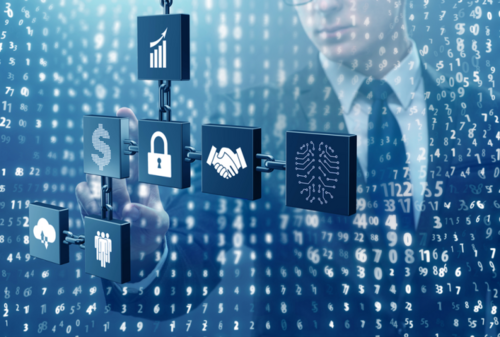
You can’t actually invest in blockchain itself, since it’s merely a system for storing and processing transactions. However, you can invest in assets and companies using this technology.
“The easiest way is to purchase cryptocurrencies, like Bitcoin, Ethereum and other tokens that run on a blockchain,” says Gray.
Another option is to invest in blockchain companies using this technology. For example, Santander Bank is experimenting with blockchain-based financial products, and if you were interested in gaining exposure to blockchain technology in your portfolio, you might buy its stock.
For a more diversified approach, you could buy into an exchange-traded fund (ETF) that invests in blockchain assets and companies, like the Amplify Transformational Data Sharing ETF (BLOK), which puts at least 80% of its assets in blockchain companies.
Despite its promise, blockchain remains something of a niche technology. Gray sees the potential for blockchain being used in more situations but it depends on future government policies. “It remains to be seen when and if regulators like the SEC will take action. One thing is evident—the goal will be to protect markets and investors,” he says.
Shtylman likens blockchain to the early stages of the internet. “It took about 15 years of having the internet before we saw the first version of Google and over 20 for Facebook. It’s hard to predict where blockchain technology will be in another 10 or 15 years, but much like the internet, it will significantly transform the ways we transact and interact with each other in the future.”
Hurdles remain, especially with the transaction limits and energy costs, but for investors who see the potential of the technology, blockchain-based investments may be a bet worth taking.
.jpg)
About: Andries vanTonder
Over 40 years selfemployed
He is a Serial Entrepreneur, an Enthusiastic supporter of Blockchain Technology and a Cryptocurrency Investor
Find me at my Markethive Profile Page | My Twitter Account | My Instagram Acount | and my Facebook Profile.
